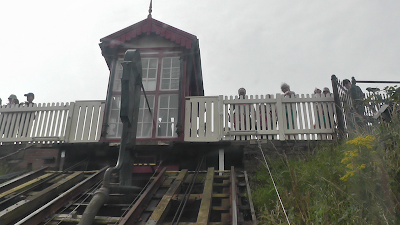In a nutshell
Gauge: 4' 8½" (so not strictly narrow gauge - but deserves an honorary mention)
Length: 207'
Opened: 1884 (previously 1870 - 1883)
Location:
Lower Promenade
Saltburn
TS12 1HQ
Tel: 01287 622528
Date of visit: 23 July 2017
Key Facts
- It is the oldest operating water-balance funicular cliff railwayin the United Kingdom
- It was first built in 1870, shortly after the Stockton and Darlington Railway (the first passenger carrying railway in the world) reached Saltburn
- It was rebuilt in its present form in 1884
- It is a water-balanced funicular railway, which means that each passenger car has a large water tank beneath the passenger compartment. When a car reaches the top of the lift, water is poured into the tank. The weight of the water counterbalances the weight of the other car which is connected to the first car with a cable. When the car reaches the bottom of the lift, the water is released from the tank and the process is repeated.
- The cars carry up to 12 passengers
- Their water tanks each hold 240 gallons (1100 litres)
- The water released at the bottom of the lift held in a large reservoir tank and the water is pumped back up to another reservoir tank at the top of the lift.
- The lift was refurbished in 1955, 1979, 1991, 2014 and 2018.
Route
My Impressions
Having visited Saltburn to photograph and ride on the Saltburn Miniature Railway, I felt I must travel on the Cliff Lift which is only a short walk from the railway. Although the lift is not narrow gauge, I felt its history and status warranted inclusion on my blog - a sort of honorary narrow gauge railway.After watching the cars rise and descend a couple of times ......
... we paid our fare at the ticket booth at the base of the lift and made our way into the carriage.
The first thing which caught our attention was the stained glass windows which had been reinstated when the lift was refurbished in 1991.
Within a few minutes our carriage filled with passengers and the doors were closed by the attendant.
Very gently, the carriage made its way up the track, passing the descending car at the half-way point.
We then reached the booth at the top of the lift, passing beside the water-filling mechanism.
We watched the attendant at the upper booth going about the business of operating the water filling machinery and braking system as the cars ascended and descended.
Finding the whole process fascinating.
Although the cost per mile of the ticket is probably quite substantial, we felt it was well worth the modest outlay to help ensure that the lift is kept operational in its original condition. The staff are clearly very proud of this piece of Victorian technology and were willing to knowledgeably discuss its maintenance and operation.









No comments:
Post a Comment